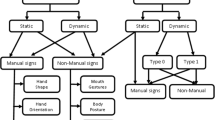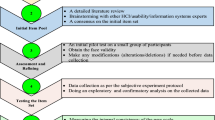Abstract
Designing multimodal systems that take the best advantage of multiple error prone recognition-based technologies, such as speech and gesture recognition, is difficult. To guarantee a robust and usable interaction, careful consideration must be given to the choice of modalities of interaction made available, their allocation to tasks, and the range of modality combinations allowed. In this paper, we present a conceptual framework for evaluating the usability and robustness of different interaction modality combinations early in the process of designing a multimodal system. First, models of multimodal elementary commands are built using Finite State Machine (FSM) modelling. Second, the most usable representations of multimodal commands are flagged up in the model by activating the FSM-based model with real or simulated user inputs. The output of this step is a collection of FSMs that more closely represent user preferences and natural behaviour. Third, the disambiguating potential of sets of multimodal commands is evaluated by observing the models response to simulated recognition errors.
Similar content being viewed by others
References
Bouchet J, Nigay L, Ganille T (2004) Icare software components for rapidly developing multimodal interfaces. In: ICMI, October 2004, pp 251–258
Bourguet M-L (2002) A toolkit for creating and testing multimodal interface designs. In: Posters and demos from the 15th annual ACM symposium on user interface software and technology, October 2002, pp 29–30
Bourguet M-L (2003) Designing and prototyping multimodal commands. In: INTERACT, September 2003, pp 717–720
Bourguet M-L (2003) How finite state machines can be used to build error free multimodal interaction systems. In: The 17th British HCI group annual conference, vol 2, September 2003, pp 81–84
Bourguet M-L (2006) A study into multimodal behaviour in error correction. In: Workshop on multimodal corpora: from multimodal behaviour theories to usable models. In association with the 5th international conference on language resources and evaluation, May 2006
Bourguet M-L, Ando A (1998) Synchronisation of speech and hand gestures during multimodal human computer interaction. In: ACM CHI’98, April 1998, pp 241–242
Bernsen NO, (2002) In: Multimodality in language and speech systems. From theory to design support tool. Kluwer Academic, Dordrecht, pp 93–148
Clow J, Oviatt SL (1998) Stamp: an automated tool for analysis of multimodal system performance. In: International conference on spoken language processing, December 1998
Coutaz GFC, Paterno F, Nigay L (1993) A comparison of approaches for specifying multimodal interactive systems. In: ERCIM workshop on multimodal human-computer interaction, November 1993
Coutaz C, Nigay L, Salber D, Blandford A, May J, Young R (1995) Four easy pieces for assessing the usability of multimodal interaction: the care properties. In: INTERACT 95, June 1995, pp 115–120
Duarte C, Carrico L (2006) A conceptual framework for developing adaptive multimodal applications. In: The 11th international conference on intelligent user interfaces, January 2006
Flippo AKF, Marsic I (2003) A framework for rapid development of multimodal interfaces. In: The 5th international conference on multimodal interfaces, November 2003
Johnston M, Bangalore S (2005) Finite-state multimodal integration and understanding. Nat Lang Eng 11:159–187
Karat CM, Halverson C, Horn D, Karat J (1999) Patterns of entry and correction in large vocabulary contentious speech recognition systems. In: ACM CHI’99, May 1999
Mankoff J, Hudson S, Abowd G (2000) Interaction techniques for ambiguity resolution in recognition-based interfaces. In: ACM UIST00, November 2000, pp 11–20
Navarre D, Palanque P, Dragicevic P, Bastide R (2006) An approach integrating two complementary model-based environments for the construction of multimodal interactive applications. In: Interacting with computers, vol 18, September 2006
Nigay L, Coutaz J (1997) Multifeature systems: The care properties and their impact on software design. In: Intelligence and multimodality in multimedia interfaces, July 1997
Oviatt S (1999) Mutual disambiguation of recognition errors in a multimodal architecture. In: ACM CHI’99, 1999, pp 576–583
Oviatt S (1999) Ten myths of multimodal interaction. Commun ACM 42(11):74–81
Oviatt S (2000) Taming recognition errors with a multimodal interface. Commun ACM 43(9):45–51
Oviatt S (2002) Breaking the robustness barrier: recent progress on the design of robust multimodal systems. Adv Comput 56:306–343
Oviatt S, Coulston R, Lunsford R (2004) When do we interact multimodally? cognitive load and multimodal communication patterns, In: ICMI 2004, October 2004
Palanque P, Schyn A (2003) A model-based approach for engineering multimodal interactive systems. In: INTERACT’03, September 2003
Sinha AK, Landay JA (2003) Capturing user tests in a multimodal, multidevice informal prototyping tool. In: 5th international conference on multimodal interfaces, November 2003
Suhm B, Myers B, Waibel A (1999) Model-based and empirical evaluation of multimodal interactive error correction. In: ACM CHI’99, May 1999, pp 584–591
VanGurp J, Bosch J (1999) On the implementation of finite state machines. In: IASTED 3rd international conference on software engineering and applications, October 1999, pp 172–178
Vuurpijl L, ten Bosch L, Rossignol S, Neumann A, Pflegfer N, Engel R (2004) Evaluation of multimodal dialogue systems. In: The 4th international conference on language resources and evaluation, May 2004
Wasinger R (2007) In: Multi modal interaction with mobile devices: fusing a broad spectrum of modality combinations. IOS, Amsterdam
Wasserman A (1985) Extending state transition diagrams for the specification of human-computer interaction. IEEE Trans Softw Eng 11(8):699–713
W3C (2007) Emma: extensible multimodal annotation markup language. December 2007
Author information
Authors and Affiliations
Corresponding author
Rights and permissions
About this article
Cite this article
Bourguet, ML., Chang, J. Design and usability evaluation of multimodal interaction with finite state machines: a conceptual framework. J Multimodal User Interfaces 2, 53–60 (2008). https://doi.org/10.1007/s12193-008-0004-2
Received:
Accepted:
Published:
Issue Date:
DOI: https://doi.org/10.1007/s12193-008-0004-2




